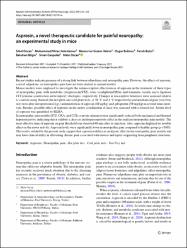| dc.contributor.author | Özcan, Sibel | |
| dc.contributor.author | Kelestemur, Muhammed Miraç | |
| dc.contributor.author | Hekim, Müğnevver Gizem | |
| dc.contributor.author | Bulmuş, Özgür | |
| dc.contributor.author | Bulut, Ferah | |
| dc.contributor.author | Bilgin, Batuhan | |
| dc.contributor.author | Canpolat, Sinan | |
| dc.date.accessioned | 2023-12-22T06:46:10Z | |
| dc.date.available | 2023-12-22T06:46:10Z | |
| dc.date.issued | 2022 | en_US |
| dc.identifier.issn | 0028-1298 / 1432-1912 | |
| dc.identifier.uri | https://doi.org/10.1007/s00210-021-02197-w | |
| dc.identifier.uri | https://hdl.handle.net/20.500.12462/13657 | |
| dc.description | Bulmuş, Özgür (Balikesir Author) | en_US |
| dc.description.abstract | Recent studies indicate presence of a strong link between adipokines and neuropathic pain. However, the effects of asprosin, a novel adipokine, on neuropathic pain have not been studied in animal models. Mouse models were employed to investigate the antinociceptive effectiveness of asprosin in the treatment of three types of neuropathic pain, with metabolic (streptozocin/STZ), toxic (oxaliplatin/OXA), and traumatic (sciatic nerve ligation/CCI [chronic constriction nerve injury]) etiologies, respectively. Changes in nociceptive behaviors were assessed relative to controls using thermal (the hot plate and cold plate tests, at 50 degrees C and 4 degrees C respectively) and mechanical pain (von Frey test) tests after intraperitoneal (i.p.) administration of asprosin (10 mu g/kg) and gabapentin (50 mg/kg) in several times intervals. Besides, possible effect of asprosin on the motor coordination of mice was assessed with a rotarod test. Serum level of asprosin was quantified by ELISA. In neuropathic pain models (STZ, OXA, and CCI), asprosin administration significantly reduced both mechanical and thermal hypersensitivity, indicating that it exhibits a clear-cut antihypersensitivity effect in the analyzed neuropathic pain models. The most effective time of asprosin on pain threshold was observed 60 min after its injection. Also, asprosin displayed no notable effect on the motor activity. Asprosin levels were significantly lower in neuropathic pain compared to healthy group (p < 0.05). The results yielded by the present study suggest that asprosin exhibits an analgesic effect in the neuropathic pain models and may have clinical utility in alleviating chronic pain associated with disease and injury originating from peripheral structures. | en_US |
| dc.language.iso | eng | en_US |
| dc.publisher | Springer | en_US |
| dc.relation.isversionof | 10.1007/s00210-021-02197-w | en_US |
| dc.rights | info:eu-repo/semantics/openAccess | en_US |
| dc.subject | Asprosin | en_US |
| dc.subject | Neuropathic Pain | en_US |
| dc.subject | Hot Plate Test | en_US |
| dc.subject | Cold Plate Tests | en_US |
| dc.subject | Von Frey Test | en_US |
| dc.title | Asprosin, a novel therapeutic candidate for painful neuropathy: An experimental study in mice | en_US |
| dc.type | article | en_US |
| dc.relation.journal | Naunyn-Schmiedebergs Archives of Pharmacology | en_US |
| dc.contributor.department | Tıp Fakültesi | en_US |
| dc.contributor.authorID | 0000-0002-3470-1783 | en_US |
| dc.contributor.authorID | 0000-0003-0455-4521 | en_US |
| dc.contributor.authorID | 0000-0002-5551-4880 | en_US |
| dc.contributor.authorID | 0000-0003-3755-3015 | en_US |
| dc.contributor.authorID | 0000-0001-7736-402X | en_US |
| dc.identifier.volume | 395 | en_US |
| dc.identifier.issue | 3 | en_US |
| dc.identifier.startpage | 325 | en_US |
| dc.identifier.endpage | 335 | en_US |
| dc.relation.tubitak | "info:eu-repo/grantAgreement/TUBITAK/119S138" | |
| dc.relation.publicationcategory | Makale - Uluslararası Hakemli Dergi - Kurum Öğretim Elemanı | en_US |


















